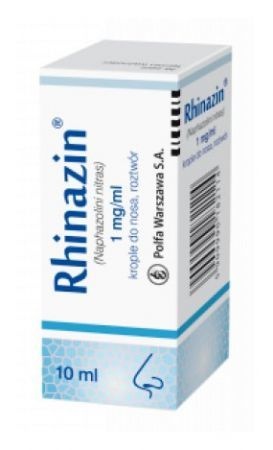

Rhinazin

Ask a doctor about a prescription for Rhinazin

How to use Rhinazin
Package Leaflet: Information for the Patient
RHINAZIN, 1 mg/ml, Nasal Drops, Solution
Naphazoline Nitrate
Read the leaflet carefully before using the medicine, as it contains important information for the patient.
This medicine should always be used exactly as described in this patient leaflet or as directed by a doctor or pharmacist.
- Keep this leaflet, you may need to read it again.
- If you need advice or further information, ask your pharmacist.
- If you experience any side effects, including those not listed in this leaflet, tell your doctor or pharmacist. See section 4.
- If after 5 days there is no improvement or you feel worse, you should contact your doctor.
Table of Contents of the Leaflet
- 1. What is Rhinazin and what is it used for
- 2. Important information before using Rhinazin
- 3. How to use Rhinazin
- 4. Possible side effects
- 5. How to store Rhinazin
- 6. Contents of the pack and other information
1. What is Rhinazin and what is it used for
Rhinazin is a nasal drop medicine containing naphazoline as the active substance, which belongs to a group of medicines called sympathomimetics.
Rhinazin, when applied locally to the nose, quickly constricts the dilated blood vessels.
It also reduces the symptoms associated with inflammation - swelling of the nasal mucosa and the amount of discharge. The medicine improves the patency of the nasal passages and facilitates the drainage of discharge from the paranasal sinuses.
Rhinazin is used as an auxiliary treatment:
- in a cold (acute and chronic inflammation of the nasal mucosa) caused by bacteria, viruses, or allergies.
2. Important information before using Rhinazin
When not to use Rhinazin:
Warnings and precautions
Before starting to use Rhinazin, you should discuss it with your doctor, especially if you have:
- high blood pressure,
- diabetes (high blood sugar levels),
- prostate enlargement,
- hyperthyroidism,
- cardiovascular diseases.
Do not exceed the recommended doses of the medicine, as temporary, local irritation and congestion of the nasal mucosa may occur.
Rhinazin should not be used for more than 5 days, as prolonged use of the medicine may cause changes in the nasal mucosa that are difficult to treat.
Rhinazin and other medicines
Tell your doctor about all the medicines you are currently taking or have recently taken, as well as any medicines you plan to take.
Do not use Rhinazin while being treated with antidepressant medicines called tricyclic antidepressants and MAO inhibitors (monoamine oxidase inhibitors).
Pregnancy and breastfeeding
If you are pregnant or breastfeeding, think you may be pregnant, or plan to have a child, ask your doctor or pharmacist for advice before using this medicine.
The use of Rhinazin during pregnancy and breastfeeding should be decided by your doctor.
Driving and using machines
Rhinazin does not affect the ability to drive and use machines.
Rhinazin contains benzalkonium chloride
The medicine contains 0.05 mg of benzalkonium chloride in each ml of solution. Benzalkonium chloride may cause irritation or swelling inside the nose, especially if used for a long time.
3. How to use Rhinazin
This medicine should always be used exactly as described in this patient leaflet or as directed by a doctor or pharmacist. If you are unsure, ask your doctor or pharmacist.
- The medicine should be used in the nose.
- For hygiene reasons, the medicine packaging should only be used by one patient.
- The medicine should not be used for more than 3 to 5 days. Longer use of the medicine should be decided by your doctor.
- Do not use higher doses than recommended. Adults and children over 6 years: locally - 1 to 2 drops into each nostril, no more often than every 4 to 6 hours.
Using a higher dose of Rhinazin than recommended
If you have used a higher dose than recommended (overdosed) or accidentally taken the medicine orally, especially if a child has done so, you should immediately contact your doctor.
Immediately consult a doctor if you experience any of the following symptoms, as they may indicate an overdose or accidental ingestion by a child:
- slow heart rate,
- lowered body temperature,
- increased or decreased blood pressure with fainting,
- increased drowsiness,
- excessive sedation.
Missing a dose of Rhinazin
Do not use a double dose to make up for a missed dose.
4. Possible side effects
Like all medicines, this medicine can cause side effects, although not everybody gets them.
Rarely (less often than 1 in 1000 people), the following may occur:
headaches and dizziness, nausea, excessive sweating, anxiety, weakness, drowsiness,
increased blood pressure, heart rhythm disturbances, increased glucose levels in the blood (hyperglycemia).
As a result of prolonged use of the medicine or higher doses than recommended, temporary swelling and congestion of the nasal mucosa with increased amount of serous-mucous discharge may occasionally occur.
Reporting side effects
If you experience any side effects, including those not listed in this leaflet, tell your doctor or pharmacist. Side effects can be reported directly to the Department of Pharmacovigilance of the Office for Registration of Medicinal Products, Medical Devices, and Biocidal Products
Al. Jerozolimskie 181C
02-222 Warsaw
Phone: +48 22 49 21 301
Fax: +48 22 49 21 309
e-mail: [email protected]
Side effects can also be reported to the marketing authorization holder.
Reporting side effects will help to gather more information on the safety of the medicine.
5. How to store Rhinazin
Store the bottle tightly closed, at a temperature below 25°C.
Keep the medicine out of the sight and reach of children.
Do not use this medicine after the expiry date stated on the carton and bottle. The expiry date refers to the last day of the month.
Medicines should not be disposed of via wastewater or household waste. Ask your pharmacist how to dispose of medicines no longer required. This will help protect the environment.
6. Contents of the pack and other information
What Rhinazin contains
- The active substance of the medicine is naphazoline nitrate. Each ml of solution contains 1 mg of naphazoline nitrate.
- The other ingredients are: boric acid, sodium chloride, disodium edetate, benzalkonium chloride solution, sodium hydroxide 10% (to adjust pH), purified water.
What Rhinazin looks like and contents of the pack
Rhinazin is a nasal drop solution. The medicine is available in polyethylene bottles containing 10 ml of solution, in a cardboard box.
Marketing authorization holder and manufacturer
Warsaw Pharmaceutical Works Polfa S.A.
Karolkowa 22/24 Street; 01-207 Warsaw
To obtain more detailed information, please contact the local representative of the marketing authorization holder:
Warsaw Pharmaceutical Works Polfa S.A.
Karolkowa 22/24 Street; 01-207 Warsaw
phone: 22 691 39 00
Date of last revision of the leaflet:
- Country of registration
- Active substance
- Prescription requiredNo
- Manufacturer
- ImporterWarszawskie Zakłady Farmaceutyczne POLFA S.A.
- This information is for reference only and does not constitute medical advice. Always consult a licensed doctor before taking any medication. Oladoctor is not responsible for medical decisions based on this content.
- Alternatives to RhinazinDosage form: Aerosol, 0.25 mg/mlActive substance: oxymetazolineManufacturer: Lomapharm GmbHPrescription not requiredDosage form: Aerosol, 0.5 mg/mlActive substance: oxymetazolineManufacturer: Lomapharm GmbHPrescription not requiredDosage form: Aerosol, 0.5 mg/ml (0.05%)Active substance: oxymetazolinePrescription not required
Alternatives to Rhinazin in other countries
The best alternatives with the same active ingredient and therapeutic effect.
Alternative to Rhinazin in Ukraine
Alternative to Rhinazin in Spain
Online doctors for Rhinazin
Discuss dosage, side effects, interactions, contraindications, and prescription renewal for Rhinazin – subject to medical assessment and local rules.








